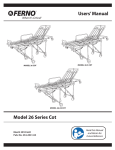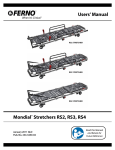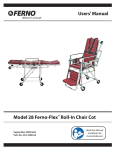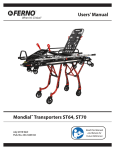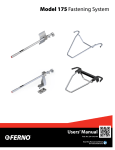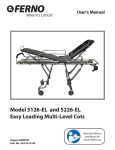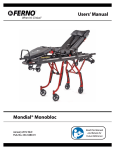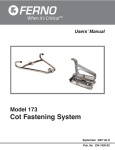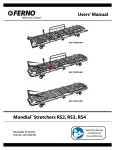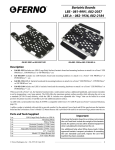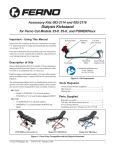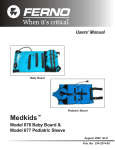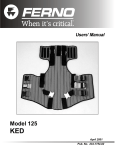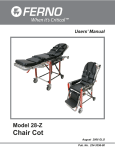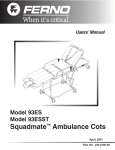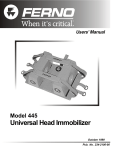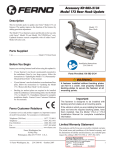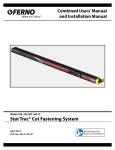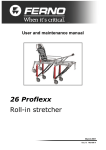Download Model 93H Series PROFlexx® Users` Manual
Transcript
Users’ Manual Model 93H Series PROFlexx® August 2013 Pub. No. 234-3402-01 Read this Manual and Retain for Future Reference 93H Series PROFlexx® Ferno Technical Support Customer service and product support are important aspects of each Ferno product. Please have the product serial number available when calling, and include it in all written communications. For technical support questions: Telephone (Toll-free) 1.800.733.3766 ext. 1010 Telephone 1.937.382.1451 ext. 1010 [email protected] users’ manual To request additional free users’ manuals, contact Ferno Customer Relations, your Ferno distributor, or visit www.ferno.com. Ferno Customer Relations For ordering assistance or general information: Canada and the U.S.A. Telephone (Toll-free) 1.877.733.0911 Telephone 1.937.382.1451 Fax (Toll-free) 1.888.388.1349 Fax1.937.382.1191 Internetwww.ferno.com All Other Locations For assistance or information, please contact your Ferno distributor. If you do not have a Ferno distributor, please contact Ferno Customer Relations: Ferno-Washington, Inc., 70 Weil Way Wilmington, Ohio 45177-9371, U.S.A. Telephone +1.937.382.1451 Fax+1.937.382.6569 Internetwww.ferno.com Serial Number _________________________ Location: Crosstube under backrest Disclaimer This manual contains general instructions for the use, operation and care of this product. The instructions are not all-inclusive. Safe and proper use of this product is solely at the discretion of the user. Safety information is included as a service to the user. All other safety measures taken by the user should be within and under consideration of applicable regulations. It is recommended that training on the proper use of this product be provided before using this product in an actual situation. Retain this manual for future reference. Include it with the product in the event of transfer to new users. Additional free copies are available upon request from Customer Relations. Proprietary Notice The information disclosed in this manual is the property of FernoWashington, Inc., Wilmington, Ohio, USA. Ferno-Washington, Inc. reserves all patent rights, proprietary design rights, manufacturing rights, reproduction use rights, and sales use rights thereto, and to any article disclosed therein except to the extent those rights are expressly granted to others or where not applicable to vendor proprietary parts. Limited Warranty Statement The products sold by Ferno are covered by a limited warranty, which is printed on all Ferno invoices. The complete terms and conditions of the limited warranty, and the limitations of liability and disclaimers, are also available upon request by calling Ferno at 1.800.733.3766 or 1.937.382.1451. 2 © Ferno-Washington, Inc 234-3402-01 August 2013 93H Series PROFlexx® Table of Contents SectionPage SectionPage Ferno Technical Support________________________ 2 Ferno Customer Relations______________________ 2 1 - Safety Information___________________________ 4 1.1Warning________________________________ 4 1.2Important_______________________________ 4 1.3Tip_____________________________________ 4 1.4 Bloodborne Disease Notice_________________ 4 1.5 Cot and Fastening System Compatibility______ 4 1.6 Symbol Glossary__________________________ 5 1.7 Safety and Instruction Labels_______________ 5 2 - Operator Skills and Training___________________ 6 2.1Skills___________________________________ 6 2.2Training_________________________________ 6 2.3 Height and Strength Considerations__________ 6 2.4 Using Additional Help_____________________ 7 3 - About the Cot________________________________ 8 3.1Description______________________________ 8 3.2 General Specifications_____________________ 9 3.3 Cot Positions____________________________ 10 4 - Setup______________________________________ 11 4.1 Ambulance Information___________________ 11 4.2 Restraints, Mattress, Accessories____________ 11 4.3 Fastener Compatibility____________________ 11 4.4 Install the Safety Hook____________________ 12 5 - Features___________________________________ 14 5.1 Undercarriage Control Handles_____________ 14 5.2 Auxiliary Lock___________________________ 14 5.3 Lead Handle____________________________ 15 5.4Mattress_______________________________ 15 5.5 Shock Frame____________________________ 15 5.6 Sidearms: Universal______________________ 16 5.7 Sidearms: Swing-Down___________________ 16 5.8 Telescoping Lift Handles__________________ 17 5.9Backrest_______________________________ 17 5.10 Drop Frame_____________________________ 18 5.11 Fastener Release Controls_________________ 19 5.12 Wheel Locks____________________________ 19 5.13 Oxygen Cylinder Holder___________________ 20 5.14 Equipment Tray (Optional)_________________ 20 6 - Using the Cot_______________________________ 21 6.1 Before Placing the Cot in Service____________ 21 6.2 General Guidelines for Use_________________ 21 6.3 Position-Change Guidelines_______________ 22 6.4 Transferring the Patient to the Cot__________ 25 6.5 Rolling the Cot__________________________ 26 6.6 One Operator, Empty Cot Folding and Unfolding____________________ 27 6.7 Loading the Cot_________________________ 28 6.8 Unloading the Cot_______________________ 30 6.9 One Operator, Empty Cot__________________ 32 7 - Maintenance_______________________________ 33 7.1 Maintenance Schedule___________________ 33 7.2 Disinfecting and Cleaning the Restraints_____ 33 7.3 Disinfecting and Cleaning the Mattress______ 33 7.4 Disinfecting the Cot______________________ 33 7.5 Cleaning the Cot_________________________ 34 7.6 Waxing the Cot__________________________ 34 7.7 Inspecting the Cot_______________________ 34 7.8 Lubricating the Cot______________________ 35 8 - Parts and Service____________________________ 36 8.1 U.S.A. and Canada_______________________ 36 8.2Worldwide_____________________________ 36 8.3 Parts List and Diagrams___________________ 36 9 - Accessories_________________________________ 38 Training Record_______________________________ 39 Maintenance Record___________________________ 39 © Ferno-Washington, Inc 234-3402-01 August 2013 3 Safety Information 93H Series PROFlexx® 1 - Safety Information 1.1Warning 1.2Important Warning notices indicate a potentially hazardous situation which, if not avoided, could result in injury or death. Important notices emphasize important usage or maintenance information. Failure to follow Important notices could result in product damage or property damage. Warning Important Untrained operators can cause injury or be injured. Permit only trained personnel to operate the cot. Helpers can cause injury. Maintain control of the cot, operate the controls, and direct all helpers. Helpers can be injured. Show helpers where to grasp the cot to avoid pinch points. 1.3Tip Tips provide recommendations for easier use of the product. Improper use of the cot can cause injury. Use the cot only for the purpose described in this manual. Attaching improper items to the cot can cause injury. Use only Ferno-approved items on the cot. Improper operation can cause injury. Operate the cot only as described in this manual. An unattended patient can be injured. Stay with the patient at all times. An unrestrained patient can be injured. Use restraints to secure the patient on the cot. An unlocked undercarriage can cause injury. Make sure the undercarriage is locked. Rolling the cot sideways or in the loading position can cause it to tip and injure the patient or operators. Roll the cot only in a level (Rolling) position and with the head end or foot end first. Improper maintenance can cause injury. Maintain the cot only as described in this manual. Improper parts and service can cause injury. Use only Ferno parts and Ferno-approved service on the cot. Modifying the cot can cause injury and damage. Use the cot only as designed by Ferno. 1.4Bloodborne Disease Notice To reduce the risk of exposure to bloodborne diseases such as HIV-1 and hepatitis when using the cot, follow the disinfecting and cleaning instructions in this manual. 1.5 Cot and Fastening System Compatibility Combining different manufacturer’s products such as a Ferno cot with a non-Ferno fastening system can increase the user’s risk of injury and damage. Ferno-Washington, Inc. cots are designed for use only with Ferno-manufactured fastening systems. Use of this Ferno cot with a non-Ferno fastening system is misuse of the Ferno product. The user assumes responsibility for the outcome of known, intentional misuse. 4 © Ferno-Washington, Inc 234-3402-01 August 2013 93H Series PROFlexx® Safety Information 1.6 Symbol Glossary The symbols defined below are used on the cot and/or in this users’ manual. Ferno uses symbols recognized by the International Standards Organization (ISO), American National Standards Institute (ANSI) and the emergency medical services industry. General Warning of Potential Injury Pinch Point: Keep Hands Clear Read the Users’ Manual Cot Operation Requires Two Trained Operators Product meets European Union Standards Do Not Lubricate 650 lb 295 kg 46.4 st Load Limit (Safe Working Load in pounds, kilograms, stone) Unlocked Locked Authorized Representative in the European Community Lubricate Manufacturer 1.7 Safety and Instruction Labels Safety and instruction labels place important information from the users’ manual on the cot. Read and follow label instructions. Replace worn or damaged labels immediately. New labels are available from EMSAR or from your distributor. See “Parts and Service” on page 36. General Information Label (1) This label provides general information for safe use of the cot. Auxiliary Lock Label (1) This label shows proper use of the auxiliary lock. Pinch Point (2) Lower Frame No Hands Area (1) The lower and upper frames meet when the cot is folded. Keep hands away from this area. The lower and upper frames meet when the cot is folded. Do not place hands or feet in this area. © Ferno-Washington, Inc 234-3402-01 August 2013 5 Operator Skills and Training 93H Series PROFlexx® 2 - Operator Skills and Training 2.1Skills Operators using the cot: ● must have a working knowledge of emergency patienthandling procedures. ● must have the ability to assist the patient. 2.2Training Operator trainees: ● must read and understand this manual. ● must be trained on the use of the cot. ● must practice with the cot before using it with a patient. ● must keep training records. For a sample training record sheet, see “Training Record” on page 39. Warning Untrained operators can cause injury or be injured. Permit only trained personnel to operate the cot. 2.3 Height and Strength Considerations When unloading the cot, the foot-end operator must lift and hold the weight of the cot, patient and equipment high enough for the wheels to remain off the ground until the undercarriage legs completely unfold and lock into place. Supporting this weight requires greater strength from short operators than from tall operators because short operators must raise their arms higher in relation to their shoulders. Be aware that if the ambulance is parked on an uneven surface, the foot-end operator (and any helpers) may need to lift the cot higher than normal to allow the legs to unfold completely and lock. Note: Use additional help as needed to lift the weight of the cot, patient and equipment. See “Using Additional Help” on page 7. 6 © Ferno-Washington, Inc 234-3402-01 August 2013 93H Series PROFlexx® Operator Skills and Training 2.4 Using Additional Help Warning Operating the cot requires a minimum of two trained operators. They may need additional help when working with heavy loads (patient plus equipment). ● Helpers can cause injury. Maintain control of the cot, operate the controls, and direct all helpers. Operators stand at the head and foot ends of the cot, maintain control of the cot, operate the controls, and direct all helpers. ● Side helpers may need to walk sideways under some circumstances. Follow local protocols. ● Ferno recommends that helpers work in pairs to help maintain cot balance. Warning Helpers can be injured. Show helpers where to grasp the cot to avoid pinch points. The chart below shows suggested placement for operators and helpers. Load Limit 650 lb 295 kg 46.4 st Inspect the cot if the load limit has been exceeded (See “Inspecting the Cot” on page 34). Directing Helpers Trained operators position themselves at the head and foot ends of the cot and operate the controls. Show helpers where to stand and how to grasp the cot. Helpers Two Operators + Two Helpers Changing Levels Rolling H H O P O O H H P P O H H O O O H H H P P H H P O O O H O H H Two Operators + Four Helpers Loading/Unloading H H H H O Key: O = Operator H = Helper P = Patient © Ferno-Washington, Inc 234-3402-01 August 2013 7 About the Cot 93H Series PROFlexx® 3 - About the Cot 3.1Description The Ferno® Model 93H Series PROFlexx® cot (called the cot in this manual) is an emergency patient-handling device designed to transport a patient in a ground-based ambulance. Warning Improper use of the cot can cause injury. Use the cot only for the purpose described in this manual. The cot is for professional use by a minimum of two trained operators. It is designed for roll-in loading to help reduce the risk of back injury to medical service personnel. The cot is designed for use with the Ferno® fastening systems (not included). Included with purchase “customer choice” options The following items are included with the purchase of a cot: One each of the following options is standard equipment on your cot. ● Mattress (1 of 4 options; see list at right) ● Set of 3 restraints ● Users’ manual ● Safety Hook (only cots equipped with the optional Safety Bar feature). ● Choice of color (contact “Ferno Customer Relations” on page 2 for current color options) ● Fastening System Compatibility ○○ Ferno® Model 175 Antler-and-Rail ○○ Ferno® Model 185 Stat Trac® ● High-Reflectivity Labels: ○○ standard high-reflectivity labels ○○ personalized high-reflectivity labels ● Sidearms ○○ Universal sidearms (swing-down and/or fold-down) ○○ Swing-down sidearms ● Mattress Options*: ○○ mattress with locking hooks ○○ mattress with locking hooks and pocket ○○ mattress with locking hooks, pocket and transfer board ○○ mattress with hook-and-loop fastener Features All cots are built with the following features: ● Clear anodized handling surfaces keep hands and clothes clean ● 5 height positions (3 level rolling positions, 1 folded position, and 1 inclined loading position) ● Auxiliary Lock (helps prevent unintended cot folding) ● High-visibility control handles (red) ● Four 6-inch U-tread swivel transport wheels, 2 with wheel locks ● Pneumatic backrest ● Drop frame (3-Position) ● Shock frame (2-Position) ● Lead handle ● Telescoping side lift handle (2) ● Head-end leg protectors ● Lower frame scuff strips ● Lower tray (metal, optional) Accessories Most accessories may be factory-installed on your cot or purchased at a later date. See “Accessories” on page 38. Note: *All mattress options are also available as accessories and as replacement parts. 8 © Ferno-Washington, Inc 234-3402-01 August 2013 93H Series PROFlexx® 3.2General Specifications Cot specifications are shown in the table at right. Ferno reserves the right to change specifications without notice. For more information, contact Ferno. See “Ferno Customer Relations” on page 2. Ferno reserves the right to change specifications without notice. ● Height measurements are as follows: ○○ ○○ Loading Position is the distance from the ground to the bottom of the loading wheel. Rolling Position is the distance from the ground to the patient surface at the telescoping handle. ● Weight is without mattress, restraints and optional features. Add 8 lb/3.6 kg for Stat Trac-version cots. ● All Ferno mattresses for emergency medical service use are fully-sealed. ® About the Cot Specification Load Limit Imperial Metric 650 lb 295 kg Load Limit (UK) 46.4 st Weight 98 lb 45 kg 67-83 in 1701-2108 mm Loading/Inclined Position (Height to Loading Wheel) 30 in 762 mm High-Level Rolling 36 in 914 mm Mid-Level Rolling 28 in 711 mm Low-Level Rolling 21 in 533 mm Folded Height 11 in 279 mm Overall 24 in 610 mm Patient Surface 19 in 483 mm 6 in 152 mm 1.75 in 44 mm Length (Minimum-Maximum) Height Width Wheels Diameter U.S.A. Notice The cot is for use with ambulances that meet the requirements of the “Star of Life” certification via Federal Ambulance Specification KKK-A-1822. For information, contact: Federal Supply Services, Specifications Section Suite 8100 470 E. L’Enfant Plaza, SW Washington, DC 20407 © Ferno-Washington, Inc 234-3402-01 August 2013 Width Cot Construction Tubular aluminum Wheel Bearings Sealed/greaseless 650 lb 295 kg 46.4 st Load Limit Inspect the cot if the load limit has been exceeded (See “Inspecting the Cot” on page 34). 9 About the Cot 93H Series PROFlexx® 3.3 Cot Positions LOADING POSITION (Inclined) - Use this position only for loading the cot into, and unloading it from, the ambulance. FOLDED POSITION - The cot is in this position when placed inside an ambulance. Loading Height Folded Height HIGH LEVEL POSITION Use this position to roll the cot. MID- and LOW-LEVEL POSITIONS High-Level Rolling Position Mid-Level Position Use these positions to roll the cot or to transfer the patient onto the cot or off from the cot. Low-Level Position 10 © Ferno-Washington, Inc 234-3402-01 August 2013 93H Series PROFlexx® Setup 4 - Setup 4.1Ambulance Information The ambulance bumper extension should not exceed 14 inches (356 mm). The patient compartment should have a level floor large enough for the folded cot, and a Ferno® cot fastener installed (not included). See “Cot and Fastening System Compatibility” on page 4. Important Loose items and debris on the patient compartment floor can interfere with the operation of the cot with the fastening system. Keep the patient compartment floor clear. Warning Attaching improper items to the cot can cause injury. Use only Ferno-approved items on the cot. Guide Strap 4.2 Restraints, Mattress, Accessories Before placing the cot in service, assign appropriate personnel to install the mattress, restraints, and any accessories shipped with the cot. A set of three restraints (Figure 1) is provided. Attach the restraints only to the cot main frame. Follow the instructions in the restraint users’ manuals (supplied separately). Keep restraint and accessory users’ manuals with this manual for future reference. For additional, free manuals, contact Ferno. See “Ferno Customer Relations” on page 2. 4.3 Fastener Compatibility The cot is compatible only with Ferno® fastening systems. See “Cot and Fastening System Compatibility” on page 4. antler-and-rail fastening system Model 93H cots are compatible with all versions of the Ferno® Model 175 antler and rail fastening system. The fastening system must be configured for use with the Model 93H Series cot. Refer to the Model 175 installation and users’ manuals for instructions on installing and using the fastening system. Model 93H users may optionally install and use a safety hook. Contact Ferno for information (see “Ferno Customer Relations” on page 2). stat trac® fastening system Model 93H-ST cots are compatible with all versions of the Ferno® Model 185 Stat Trac® fastening system. The center of the Stat Trac must be a minimum of 17" (431.8 mm) from the ambulance wall. If the Stat Trac was installed closer than this minimum distance, it must be re-installed further from the wall to provide room for the cot wheels to swivel during loading and unloading. © Ferno-Washington, Inc 234-3402-01 August 2013 Model 417-1 Harness Restraint Model 430 Restraint (2) Figure 1 - Restraints (Set of 3) Important Owners of Stat Trac® fastening systems: The 93H-ST Series cots have 6"/152 mm wheels, which requires the Stat Trac to be installed at least 17”/431.8 mm from the side walls. Installing closer than 17”/431.8 mm may not allow clearance for the wheels to swivel when unloading the cot from the ambulance. If you installed a Stat Trac closer to the ambulance side wall prior to June 1, 2000, you must adjust your Stat Trac to the new 17”/431.8 mm minimum wall clearance. Center-mounted Stat Tracs and those installed 17”/431.8 mm or more from the wall do not require adjustment. Follow the instructions in the Stat Trac Installation Manual. For a free manual, contact Ferno (see “Ferno Customer Relations” on page 2). 11 Setup 93H Series PROFlexx® 4.4Install the Safety Hook Hook If your ambulance service uses only the Stat Trac Fastening system, skip the rest of Section 4. If none of your Model 93H cots have the optional safety bar, skip the rest of Section 4. If you purchased a 93H cot with the optional safety bar/ safety hook, follow the instructions in this section to install the safety hook (Figure 2) on the ambulance floor. The intent of the safety hook is to catch the cot safety bar (Figure 3). During the loading and unloading process, the operators must guide the cot toward the safety hook and visually confirm that the safety bar has been captured by the safety hook. This secures the cot inside the ambulance while the operators unlock and raise or lower the undercarriage legs. Installing the safety hook requires the skills of a mechanic familiar with ambulance construction. Front Edge Figure 2 - Safety Hook Important Before installing the safety hook, consult the ambulance manufacturer about interference with wiring and other elements under the ambulance floor, and about the ambulance warranty. Before installing the safety hook, consult the ambulance manufacturer regarding: ● the location of wiring, oxygen or fuel lines, and other elements under the ambulance floor. ● the ambulance warranty. Hardware required (not supplied) 1/4"-20 flathead machine screws* Flat washers Lock washers 1/4"-20 nuts 2 ea 2 ea 2 ea 2 ea *The machine screws must be long enough to pass through the safety hook, patient compartment floor, both washers, and still have at least two full threads extending past the nut. The hardware should be of at least SAE Grade 5 with UNC-2 threading (or equivalent). 12 Figure 3 - Engaging the Safety Hook © Ferno-Washington, Inc 234-3402-01 August 2013 93H Series PROFlexx® Setup Important Position the safety hook aligned with the center of the fastening system antler, and as close to the rear of the ambulance as possible, within the limits below: ● The bumper or extended folding bumper must not exceed 14"/356 mm. 11.125"/283 mm Maximum ● Position the safety hook with the hook facing the front of the ambulance. Bumper or Extended Bumper Step ● Inset the safety hook at least 11"/279 mm from each side of the door frame (Figure 4). ● Algin the safety hook on the centerline of the fastening system to maximize the opportunity for the cot safety bar to catch the hook. ● ● Position the safety hook no more than 11.125"/283 mm from the front edge of the hook to the rear of the ambulance, including the bumper and folding bumper step in the extended (open) position. Minimum Inset from Door Frame 11"/279 mm Proper safety hook placement Minimum Inset from Door Frame 11"/279 mm If the safety hook is installed too far inside the ambulance, you will not be able to properly fold or unfold the cot undercarriage when it is secured by the hook. Measure and install the safety hook as instructed in this manual. 3.75"/95 mm Minimum Figure 4 - Safety Hook Placement Socket-Head Cap Screw Ambulance Rear Ambulance Front Position the safety hook at least 3.75"/95 mm from the rear edge of the hook to the doorjamb. This ensures the cot loading wheels are on the ambulance floor when the safety bar is held by the safety hook. Hook Front Edge Installing the safety hook 1. Mark the position of the safety hook on the floor. 2. Drill holes for the flat-head machine screws and attach the safety hook to the floor (Figure 5). 3. To test the hook, load and unload the cot. Verify that there is no interference with folding or unfolding the undercarriage legs. Flat Washer Lock Washer Nut Figure 5 - Installing the Safety Hook © Ferno-Washington, Inc 234-3402-01 August 2013 13 Features 93H Series PROFlexx® 5 - Features 5.1 Undercarriage Control Handles ● Location: Each end of the cot (Figures 6-7). The control handles are red in color. ● Purpose: Squeezing the control handles disengages the undercarriage lock and allows the cot to be raised or lowered. ● Use: Grasp the cot main frame with an underhand grip (palms up), with your right hand positioned to reach and squeeze the control handle. ○○ ○○ Operators lift the cot off its wheels both before and after using a control handle. This removes the weight from the locking mechanism and allows it to disengage or engage fully. Figure 6 - Foot-End Undercarriage Control Handle For complete operating instructions, see “Using the Cot” on page 21. Figure 7 - Head-End Undercarriage Control Handle 5.2Auxiliary Lock ● Location: Patient left side of the cot, near the foot end (Figure 8). It is accessible to both operators. ● Purpose: The engaged auxiliary lock prevents the undercarriage from moving to the folded position. The auxiliary lock engages automatically when the cot is moved from the folded position directly to the loading (inclined) position. This occurs in two situations: ● ○○ When the cot is unloaded from the ambulance. ○○ When the cot is raised from the folded position to the loading position. Use: Keep the auxiliary lock engaged when changing cot positions. Unlock it only when loading the cot into an ambulance. See “Loading the Cot” on page 28. Figure 8 - Auxiliary Lock 1. Lift the red secondary lock lever (Figure 8). 2. While continuing to lift the secondary lock lever, slide the unpainted lock lever to the right (toward the head end of the cot). 14 © Ferno-Washington, Inc 234-3402-01 August 2013 93H Series PROFlexx® Features 5.3Lead Handle ● Location: Cot foot end (Figure 9). ● Purpose: Allows the cot to be pulled when it is being rolled on a smooth, level surface (See “Rolling the Cot” on page 26). ● Use: Swing the handle out for use (Figure 9). Store the lead handle in the folded position. Figure 9 - Using the Lead Handle 5.4Mattress ● Purpose: The mattress provides comfort for the patient. There are four mattress options: ○○ ○○ ○○ ○○ ● Mattress with 5 hooks (Figure 10) Mattress with 5 hooks and a transfer-board pocket (transfer board included) Mattress with 5 hooks and a transfer-board pocket (transfer board not included) Mattress with hook-and-loop fastening strips. Use: The bottom of the mattress has either 5 plastic hooks or hook-and-loop fastening strips. The hooks or hook-and-loop strips help hold the mattress in place when transferring a patient onto or off from the cot. ○○ To attach: Raise the backrest and/or shock frame as needed. Feed each hook through a hole in the bed surface (Figure 11) OR press the hook-andloop surfaces together. ○○ To remove: Slide one hand under the mattress and apply upward pressure, then remove each hook from the bed surface with your other hand OR separate the hook-and-loop fastening strips. 5.5 Shock Frame ● Location: Cot foot end (Figure 12). ● Purpose: Elevate the patient’s legs to treat shock or for patient comfort. Follow local protocols for appropriate use of the shock frame. ● Raising: Unfasten or loosen the leg restraint(s) before adjusting the shock frame position. Standing at the foot end of the cot, use both hands to raise the shock frame until it locks. Fasten and adjust the restraint(s) after completing the position change. ● Lowering: Lift the shock frame to support the weight, then press the release levers (Figure 12) and lower the shock frame. Fasten and adjust the restraint(s) after completing the position change. © Ferno-Washington, Inc 234-3402-01 August 2013 Figure 10 - Mattress with Hooks Figure 11 - Mattress Attached to Backrest Release Lever (2) Figure 12 - Lowering the Shock Frame 15 Features 5.6 Sidearms: Universal ● 93H Series PROFlexx® Important Purpose: Sidearms provide patient security and comfort. Universal sidearms (Figure 13) fold down along the cot main frame or swing down like a traditional sidearm. Do not use the sidearms to lift the cot. Sidearms are not designed for lifting. Lift the cot only by grasping the main frame, or main frame and lift handles. The intermediate position allows a patient’s arm to be placed on the sidearm for treatment, starting of intravenous (IV) fluids, etc. Sidearms are designed to support light objects. Do not place objects weighing more than 10 pounds (4.5 kg) on the sidearms. Keep the sidearms raised except during patient transfer. ● Use: ○○ Folding Feature: To fold, press the release lever and fold the sidearm flat along the cot main frame. To raise, lift the sidearm toward the head-end of the cot until it locks in the raised position. ○○ Swing-Down Feature: To swing down, press the release lever, pull the sidearm slightly toward the foot-end of the cot to free it from the lock, then swing down. To raise, swing the sidearm up while moving it toward the head end of the cot until it locks in the raised position. ○○ Middle Stop: To lower to the middle stop, press the release lever and begin folding and lowering the sidearm, then slide the sidearm toward the head-end of the cot to lock it before lowering it to the 90° point. 5.7 Sidearms: Swing-Down ● Purpose: Sidearms provide patient security and comfort. Swing-down sidearms swing down below the cot main frame. The intermediate position allows a patient’s arm to be placed on the sidearm for treatment, starting of intravenous (IV) fluids, etc. Keep the sidearms raised except during patient transfer. ● Figure 13 - Unlocking the Universal Sidearm Important Do not use the sidearms to lift the cot. Sidearms are not designed for lifting. Lift the cot only by grasping the main frame, or main frame and lift handles. Sidearms are designed to support light objects. Do not place objects weighing more than 10 pounds (4.5 kg) on the sidearms. Use: To lower, squeeze the release handle (Figure 14) and lower the sidearm. To raise: Lift the sidearm until it locks. You do not need to use the release handle. To use the intermediate position: Let go of the release handle before the sidearm reaches the 90° point. Figure 14 - Unlocking the Swing-Down Sidearm 16 © Ferno-Washington, Inc 234-3402-01 August 2013 93H Series PROFlexx® Features 5.8 Telescoping Lift Handles ● Location: Near the center of the cot, between the main frame and the patient surface (Figure 15). ● Purpose: Used together, the lift handles provide extra lifting or grasping points for helpers or operators to raise, lower, roll, or carry the cot. ● Use: Pull the handle to extend; push to retract. To maintain cot balance, use both lift handles. Grasp the lift handle with both hands, or grasp with one hand (using a cylindrical or “power” grip) while grasping the main frame with your other hand (using an underhand grip). Figure 15 - Extending a Telescoping Lift Handle 5.9Backrest Purpose: Use the backrest to elevate the patient’s torso for patient comfort or when medically necessary. The backrest can be adjusted between 0° and 75°. ● Use: 1. Loosen or unbuckle the torso restraint. 2. Support the weight of the backrest and patient. 3. Press the red control handle toward the backrest to unlock it (Figure 16), then raise or lower the backrest to the desired position. 4. Release the control handle to lock the backrest at the desired position. 5. Fasten and adjust the restraint after completing the position change. Note: The gas spring is under pressure to ease raising and lowering. When a heavy patient is on the cot, support the patient’s weight before adjusting the backrest. When a light patient is on the cot, control the upward movement of the backrest so it does not move too quickly. ● © Ferno-Washington, Inc 234-3402-01 August 2013 Figure 16 - Using the Backrest 17 Features 93H Series PROFlexx® 5.10 Drop Frame ● Purpose: The drop frame adjusts to three positions (Figure 17) to shorten the cot or to provide good ergonomic lifting angles for raising or lower the cot. If equipped, the optional safety bar is attached to the drop frame and is used to secure the cot to the safety hook in the ambulance during the loading and unloading process. ● ○○ Folded (Unlocked): Use the folded position to shorten the overall length of the cot when space is limited. The frame is unlocked in this position do not use this position for lifting the cot. ○○ Middle (Locked): Use the middle (locked) position to provide the head-end operator to gain better leverage for lifting. ○○ Extended (Locked): Use the extended position for all other cot functions, including loading and unloading the cot into and out from an ambulance. Use: Squeeze the red release bar to adjust the drop frame (Figure 18). To lock, let go of the release bar and continue moving the frame until it stops at a locked position. Drop Frame Positions The drop frame must be locked n the extended position when loading the cot into an ambulance or unloading it from an ambulance. Do not fold the cot when the drop frame is in a lowered position. Figure 17 - Drop Frame Positions The drop frame is not locked in the folded position. You do not need to squeeze the release bar to raise the drop frame from the folded to the middle position. Simply raise the frame until it locks. Figure 18 - Drop Frame Release Bar 18 © Ferno-Washington, Inc 234-3402-01 August 2013 93H Series PROFlexx® Features 5.11 Fastener Release Controls ● Purpose: For ambulances equipped with a safety hook or a Stat Trac® fastening system with safety stop, the fastener release controls allow the cot to be disengaged from these safety features at the appropriate time. See “Loading the Cot” on page 28 or “Unloading the Cot” on page 30 ● Options: ● ○○ Model 93H cots with the optional safety bar are equipped with a fastener release lever for use with the safety hook. ○○ Model 93H cots without the optional safety bar do not have a fastener release lever. ○○ Model 93H-ST cots are equipped with a fastener release handle for use with the Stat Trac®. Figure 19 - Fastener Release Lever Use: ○○ Model 93H with safety bar: Turn the fastener release lever counter-clockwise (Figure 19). ○○ Model 93H-ST: Squeeze the fastener release handle (Figure 20). Figure 20 - Fastener Release Handle 5.12 Wheel Locks ● Location: One transport wheel at each end of the cot, accessible to the operator’s right foot (Figure 21). ● Purpose: Stops wheel rotation (when engaged). Wheel locks help keep the cot stationary during patient transfer and certain medical procedures. ● Use: Press the lock lever to engage; lift the lever up to disengage. Wheel locks are not brakes. Remain with the cot and keep control of it at all times. Do not leave the cot or patient unattended. © Ferno-Washington, Inc 234-3402-01 August 2013 Figure 21 - Engaging a Wheel Lock 19 Features 93H Series PROFlexx® 5.13 Oxygen Cylinder Holder ● Location: Cot foot end, between the end of the patient surface and the control handle (Figure 22). ● Purpose: The holder secures a “D” or “Jumbo-D”sized oxygen cylinder, up to 5.3" (135 mm) in diameter and 18.75" (476 mm) in length. (Spiracle Technologies “DD-Lite” oxygen cylinder is also compatible). ● Use: To secure an oxygen cylinder on the holder: 1. Open the attached fastening straps and center the cylinder on the holder. 2. Wrap the straps around the cylinder and thread them through the D-rings (Figure 23). 3. Cinch the straps tight, then secure them by pressing the hook-and-loop surfaces together. Figure 22 - Oxygen Cylinder Holder To remove the oxygen cylinder, separate the hook-and-loop fastening strips, un-cinch the straps from the D-rings, and remove the cylinder from the holder. Placing the Oxygen Cylinder Orient the oxygen cylinder so the regulator will not interfere with cot operation. Figure 23 - Securing the Oxygen Bottle 5.14Equipment Tray (Optional) ● Location: A metal lower tray (Figure 24) is available as a build option, or is available as an accessory. A vinyl lower tray is available as an accessory (see “Accessories” on page 38). Both tray versions attach to the cot lower frame. ● Purpose: The tray can hold items while the cot is being rolled. 20 ○○ Include the weight of items placed on the tray when calculating the total load on the cot. ○○ Be aware of the height of items placed on the tray and remove them before changing cot positions if they will interfere with the function of the cot. ○○ Always remove all items from the tray before folding the cot or loading it into an ambulance. Figure 24 - Metal Equipment Tray Option © Ferno-Washington, Inc 234-3402-01 August 2013 93H Series PROFlexx® Using the Cot 6 - Using the Cot 6.1Before Placing the Cot in Service ● Before using the cot, personnel who will work with the cot must read and understand this manual. Appropriate skills and training are also required. See “Operator Skills and Training” on page 6. ● Set up the cot, following the instructions in the Setup section. See “Setup” on page 11. ● Confirm that the cot operates properly. See “Inspecting the Cot” on page 34. ● The vehicle must have a Ferno® fastening system installed. 6.2General Guidelines for Use ● Medical advice is beyond the parameters of this manual. ● It is the users’ responsibility to ensure safe practices for the patient and themselves. ● A minimum of two trained operators is required. ● Follow standard emergency patient-handling procedures when operating the cot. ● Operators must work together and maintain control of the cot at all times. ● Operators must communicate with one another and use coordinated movements to operate the cot. ● Operators must stay with the patient at all times. ● Always use patient restraints to secure the patient on the cot. ● Lift only the weight you can safely handle. Use additional help when working with heavy loads (patient and equipment). For placement of helpers, see “Using Additional Help” on page 7. ● When changing cot positions or loading/unloading, verify that the undercarriage has locked into the new position. ● Read the cot fastener users’ manual for instructions on using the cot fastener. See “Cot and Fastening System Compatibility” on page 4. ● Always roll the cot using a rolling position. Use the loading position only when loading the cot into, or unloading it from, an ambulance. © Ferno-Washington, Inc 234-3402-01 August 2013 650 lb 295 kg 46.4 st Read the Users’ Manual Operation Requires Two Trained Operators Load Limit (Safe Working Load) Warning Improper operation can cause injury. Operate the cot only as described in this manual. Warning An unattended patient can be injured. Stay with the patient at all times. Warning An unrestrained patient can be injured. Use restraints to secure the patient on the cot. Warning An unlocked undercarriage can cause injury. Make sure the undercarriage is locked. Warning Rolling the cot sideways or in the loading position can cause it to tip and injure the patient or operators. Roll the cot only in a level (Rolling) position and with the head end or foot end first. 21 Using the Cot 93H Series PROFlexx® 6.3 Position-Change Guidelines Important ● Changing cot positions with a patient on the cot requires a minimum of two trained operators who are communicating, working together, and maintaining control of the cot at all times. ● Operators stand at opposite ends of the cot, using an underhand grip (palms up) to grasp the cot main frame with both hands. ● Lift the weight of the cot off its wheels (and locking mechanism) before squeezing a control handle (see “Undercarriage Control Handles” on page 14). ● Be prepared to control the normal downward movement of the cot that occurs when a control handle is squeezed. Checking the Undercarriage Lock Engagement ● To ensure patient comfort, both operators control the movement of the cot until it locks into the new position. To verify that the cot undercarriage is locked into its new position, both operators lift the cot until the transport wheels are off the ground. ● Verify that the undercarriage is locked into the new position before releasing your grasp on the frame. ● If local protocols allow, one operator may raise or lower an empty cot (see “One Operator, Empty Cot Folding and Unfolding” on page 27). This allows the undercarriage to lock into place if it has not already done so. Visually check to make sure the auxiliary lock is engaged. ● Always support the weight of the cot before squeezing a control handle. ● Operators should expect and be prepared to control the normal downward movement of the cot which occurs when a control handle is squeezed. ● Before you release your grasp on the frame, verify that the undercarriage has locked. Once you have verified that the undercarriage is locked and the auxiliary lock is engaged, lower the cot onto its transport wheels. Know the Cot’s Position Paths ● The cot moves directly between the folded and loading (inclined) positions with no intermediate stops. ● When the cot is in either the high-level position or the loading position, the head-end operator can adjust between these two positions by adjusting only the head-end of the cot. ● When the cot is in a level position, the operators can raise or lower it to any other level position. (high-level, mid-level, low-level). ● The head end of the cot must be raised to the loading (inclined) position before the cot may be loaded into an ambulance, or folded. ● For raising and lowering instructions, refer to the instructions in the rest of this section. ● For loading instructions, see “Loading the Cot” on page 28 or “Unloading the Cot” on page 30. Loading to Folded; Folded to Loading (No Intermediate Positions) Three Level Positions Total (High-Level and Low-Level Shown) 22 © Ferno-Washington, Inc 234-3402-01 August 2013 93H Series PROFlexx® Using the Cot Folded position to Loading Position The cot moves between the loading and folded positions with no intermediate stops. 1. Both Operators: Grasp the folded cot’s main frame with an underhand grip (Figure 25). Lift the cot until the undercarriage unfolds completely and locks in the loading position. The auxiliary lock will engage automatically. Visually check to verify that the auxiliary lock lever has moved to the “locked” position as shown in Figure 26. Figure 25 - Raising the Cot from the Folded Position 2. Both Operators: Continue supporting the weight of the cot as you verify that the undercarriage has locked into position (see “Checking the Undercarriage Lock Engagement” on page 22). When you are sure the undercarriage is locked, release your grasp on main frame. 3. Both Operators: In the loading position, the cot is at its maximum height and is inclined at the head end. Before rolling the cot, adjust it to a rolling position (see “Lowering: Loading to High-Level Position” on page 24). loading position to folded position The cot cannot be folded with a patient on it. To load a cot with a patient into an ambulance, see “Loading the Cot” on page 28. Figure 26 - Auxiliary Lock in Locked Position An empty cot may be folded or unfolded by one operator if local protocols allow. See “One Operator, Empty Cot Folding and Unfolding” on page 27. © Ferno-Washington, Inc 234-3402-01 August 2013 23 Using the Cot Raising: high-level to loading position Note: Only the Head-End Operator operates an undercarriage control handle (Figure 27). 1. Foot-End Operator: Grasp the cot main frame. Lift slightly but do not use the control handle as the head-end operator makes the position adjustment. 2. Head-End Operator: Squeeze the control handle and raise the head-end frame. As soon as the frame begins to move, release the control handle. 3. Head-End Operator: Continue moving the frame until it locks into the new position. Lowering: Loading to High-Level Position Note: Only the Head-End Operator operates an undercarriage control handle (Figure 27). 1. Foot-End Operator: Grasp the cot main frame. Hold the cot steady as the head-end operator makes the position adjustment. 2. Head-End Operator: Squeeze the control handle and lower the head-end frame. As soon as the frame begins to move, release the control handle. 3. Head-End Operator: Continue moving the frame until it locks into the new position. changing between rolling positions Once the cot is in one of the three rolling positions (See “Cot Positions” on page 10), it can be raised or lowered to any position except folded. ● When lowering the cot, begin lowering the cot head end before lowering the foot end. This allows the undercarriage to change positions more easily. ● When changing positions, ensure patient comfort by controlling the movement of the cot until it has locked into the new position. ● Adjust the drop frame to suit the operator’s height before and/or after the position change. To change between rolling positions: 1. Both Operators: Grasp the cot main frame and lift the load off the undercarriage while keeping the wheels on the ground (Figures 28-29). 2. Both Operators: Squeeze the control handles and begin raising or lowering the cot. Release the control handles when the cot is near its desired position. 3. Both Operators: Continue raising or lowering the cot until the undercarriage locks into the new position. 93H Series PROFlexx® Moving Between Loading and High-Level Positions To adjust between the loading and highlevel positions, only the Head-End Operator squeezes his/her control handle. If the Foot-End Operator squeezes his/her control handle, the cot could descend past the high-level position. Head-End Operator: Lift and Adjust Cot Foot-End Operator: Lift But Do Not Use Control Handle Figure 27 - Raising to the Loading Position Figure 28 - Raising the Cot Figure 29 - Lowering the Cot 24 © Ferno-Washington, Inc 234-3402-01 August 2013 93H Series PROFlexx® Using the Cot raising to the loading position from a mid- or low-rolling position To raise the cot from the mid-level or low-level rolling position to the loading position (Figure 30): 1. Both Operators: Squeeze the control handles and Raise the cot completely. Head-End Operator: Remember to lift your end of the cot higher than the Foot-End Operator. 2. Both Operators: Release the control handles as the cot nears the rolling position. Verify that the cot has locked into the loading (inclined) position. Figure 30 - Raising to the Loading Position 6.4 Transferring the Patient to the Cot To transfer a patient onto the cot: 1. Unfasten the restraints. Arrange the straps so they will not interfere with transferring the patient onto the cot. 2. Place the cot beside the patient and adjust it to the patient’s level. 3. Lower or fold the sidearms and retract the side lift handles. 4. Engage the wheel locks. 5. Transfer the patient onto the cot using approved EMS procedures and your local protocols. Figure 31 - Securing the Patient 6. Raise the sidearms. Adjust the backrest and shock frame as needed. 7. Fasten and adjust the patient restraints (Figure 31). 8. Release the wheel locks. 9. Before moving the cot or changing its position, make sure sheets and other articles will not interfere with cot operation. © Ferno-Washington, Inc 234-3402-01 August 2013 25 Using the Cot 6.5 Rolling the Cot ● ● ● ● ● ● ● ● General guidelines Rolling the cot with a patient on the cot requires a minimum of two trained operators who are communicating, working together, and maintaining control of the cot at all times. Rolling the cot in a loading position can increase the chance for the cot to tip. Always use a rolling position to roll the cot. See “Cot Positions” on page 10. Roll the cot on smooth, unobstructed surfaces whenever possible. To cross a low obstacle such as a door sill, lift the cot slightly to take the weight off the wheels so the wheels roll smoothly over the obstacle. Lift and carry the cot over a high obstacle such as a curb. Do not apply downward force on one end of the cot in order to raise the other end of the cot. Do not roll the cot sideways. Rolling a cot sideways can increase the chance for the cot to tip and injure the patient and/or operators. Use additional help as needed to safely control the weight of the patient and cot (see “Using Additional Help” on page 7). When rolling over rough terrain, the operators (and helpers) should grasp the cot with both hands. 93H Series PROFlexx® Warning Rolling the cot sideways or in the loading position can cause it to tip and injure the patient or operators. Roll the cot only in a level (Rolling) position and with the head end or foot end first. Important Roll the cot downhill foot-end first. If it is not medically appropriate to do this, roll the cot head-end first, but do the following: To maintain cot balance while rolling the cot downhill head-end first, the Head-end Operator must exert upward force on the drop frame. rolling the cot 1. Securely fasten the restraints around the patient. 2. Both Operators: Place the cot in a rolling position. See “Cot Positions” on page 10. 3. Both Operators: Position yourselves at the sides of the cot; grasp the main frame with both hands, and roll the cot (Figure 32). Attend to, and communicate with the patient. Smooth, Level Surface Only: As an alternate method, the operators position themselves at the ends of the cot. The foot-end Operator unfolds the lead handle to pull the cot (Figure 33). Figure 32 - Rolling the Cot Note: Grasp only the cot main frame, not the lead handle, when rolling the cot on rough surfaces or uneven terrain. Figure 33 - Rolling With the Lead Handle 26 © Ferno-Washington, Inc 234-3402-01 August 2013 93H Series PROFlexx® Using the Cot 6.6 One Operator, Empty Cot Folding and Unfolding When the cot is empty (no patient), one trained operator may fold the cot or raise it from the folded to the loading position. These are the only one-operator position changes that can be made. folding an empty cot 1. Unlock the auxiliary lock. See “Auxiliary Lock” on page 14. 2. Move to the cot foot end and grasp the main frame. 3. Lift the foot end and tip the head end of the cot until the cot rests on its loading wheels and head-end transport wheels (Figure 34). 4. While supporting the foot end of the cot, squeeze the control handle and fold the cot. Figure 34 - One Operator Folding An Empty Cot unfolding an empty cot 1. Squat at the foot end of the folded cot and grasp the main frame (Figure 35). 2. Lift the cot until the undercarriage unfolds and locks into the loading position. The cot will be resting on its loading wheels and head-end transport wheels (Figure 34). 3. Visually check that the auxiliary lock has moved into the locked position. 4. Lower the foot end of the cot until all four transport wheels rest on the ground. © Ferno-Washington, Inc 234-3402-01 August 2013 Figure 35 - One Operator Unfolding An Empty Cot 27 Using the Cot 93H Series PROFlexx® 6.7Loading the Cot Patient Compartment Top View Preparing to Load the Cot Loading the cot into an ambulance with a patient on it requires a minimum of two trained operators who are communicating, working together, and maintaining control of the cot at all times. See “Operator Skills and Training” on page 6 and “Using Additional Help” on page 7. 1. Raise the ambulance folding bumper, if present. 2. Roll the cot to the patient compartment door. 3. Extend the drop frame. 4. Both Operators: Raise the cot to the loading position (see “Cot Positions” on page 10). 5. Both Operators: As you load the cot into the ambulance, align the cot with, and keep it parallel to, the ambulance side walls (Figure 36). Guide the cot straight into the cot fastening system antler (or Stat Trac funnel). Antler Figure 36 - Align the Cot With the Ambulance Walls Loading the Cot 1. Both Operators: Roll the cot into the open patient compartment until both loading wheels are on the patient compartment floor. Note: Skip to Step 3 on page 29 if your cot does not have a safety bar or Stat Trac fastening posts. 2. 93H with Safety Bar Cots (Figure 37): ○ Head-End Operator: Help guide the cot toward the safety hook so the safety hook will catch the center of the safety bar. Visually confirm that the safety bar has been captured by the safety hook ○ Both Operators: Verify the safety bar passes the safety hook. ○ Both Operators: Verify the safety bar has captured the safety hook by attempting to pull the cot out of the ambulance (the cot must be stopped by the hook). Figure 37 - Engaging the Safety Hook Safety Stop or 2. 93H-ST (Figure 38): 28 ○ Both Operators: Verify the head-end loading post passes the Stat Trac® safety stop. ○ Both Operators: Verify the loading post has been captured by the safety stop by attempting to pull the cot out of the ambulance (the cot must be stopped by the safety stop). Figure 38 - Engaging the Safety Stop © Ferno-Washington, Inc 234-3402-01 August 2013 93H Series PROFlexx® Using the Cot Important If the ambulance is parked on an uneven surface, the operators (and any helpers) may need to lift the cot higher than normal to allow the undercarriage to lock. Important To recover from a loading attempt halted by the auxiliary lock, do the following: 1. Release the undercarriage control handle. 2. Return the cot to its transport wheels. Verify that the undercarriage is securely locked. 3. Unlock the auxiliary lock. 4. Resume the loading procedure. Figure 39 - Loading the Cot 3. Either Operator: Unlock the auxiliary lock. 4. Foot-End Operator: Lift the cot foot end until it is level with the ambulance floor, or until the transport wheels are off the ground, whichever makes the cot foot end higher (Figure 39). 5. Foot-End Operator: Squeeze and hold the control handle. Communicate to the Head-End Operator to lift the undercarriage. 6. Head-End Operator: When the Foot-End Operator communicates that he/she is ready, grasp the lifting grip, lift and fold the undercarriage (Figure 39). 7. Both Operators: If the loading process is halted by the auxiliary lock, refer to the Important box above to stop the loading process and correctly recover and prepare to load the cot. 8. Both Operators: Push the cot into the ambulance (Figure 40). 9. Foot-End Operator: Release the undercarriage control handle. Figure 40 - Loading the Cot 10. Both Operators: Secure the cot in the cot-fastening system. © Ferno-Washington, Inc 234-3402-01 August 2013 29 Using the Cot 6.8 Unloading the Cot Unloading the cot from an ambulance with a patient on it requires a minimum of two trained operators who are communicating, working together, and maintaining control of the cot at all times. See “Operator Skills and Training” on page 6 and “Using Additional Help” on page 7. preparing to unload the cot 93H Series PROFlexx® Warning An unlocked undercarriage can cause injury. Make sure the undercarriage is locked. Patient Compartment Top View 1. Both Operators: Raise the folding bumper, if present. Release the cot from the fastening system. 2. Foot-End Operator: Grasp the cot foot-end frame but do not squeeze the undercarriage control handle. As you roll the cot out of the ambulance: ○○ Keep the cot level with the ambulance floor and parallel with the ambulance side walls as you roll it out of the ambulance (Figure 41). ○○ Provide balance, support the load, and watch for the undercarriage legs to lock. Antler unloading the cot Note: The next step depends on your ambulance setup. 1. Both Operators: Begin pulling the cot from the ambulance. The Foot-End Operator grasps the cot foot-end frame while the Head-End Operator grasps the lifting grip. ○○ 93H: Keep the loading wheels inside the ambulance until the undercarriage legs have unfold completely and lock. ○○ 93H with Safety Bar: Guide the cot toward the safety hook, so the safety hook will catch the center of the safety bar. Verify the undercarriage legs unfold completely and lock before releasing the safety bar from the safety hook. ○○ 93H-ST: Roll the cot out of the ambulance until the head-end loading post is caught by the Stat Trac® safety stop. Verify the undercarriage legs unfold completely and lock before releasing the cot from the Stat Trac®. Figure 41 - Align the Cot With the Ambulance Walls Important Keep the loading wheels on the patient compartment floor (or keep the cot secured by the safety hook or safety stop) until the undercarriage unfolds completely and locks into place. An unlocked undercarriage will allow the cot to fold. 2. Foot-End Operator: Lift and hold the foot end of the cot high enough for the undercarriage to unfold completely and lock (Figure 42), then lower the cot until the transport wheels are on the ground. Assisting Operator: As the cot is pulled from the ambulance, grasp the undercarriage hand grip (Figure 42) and lower the undercarriage to the ground. Figure 42 - Unloading the Cot 30 © Ferno-Washington, Inc 234-3402-01 August 2013 93H Series PROFlexx® Using the Cot Important If the ambulance is parked on an uneven surface, the operators (and any helpers) may need to lift the cot higher than normal to allow the undercarriage to lock. Important Verify that the undercarriage is locked before operating the fastener release lever or release handle. An unlocked undercarriage will allow the cot to fold. 3. Foot-End Operator: Lift the cot until all four transport wheels are off the ground to verify the undercarriage has unfolded completely and is locked. Set the cot on the ground. Figure 43 - Releasing the Cot from a Safety Hook 4. Head-End Operator: If present, use the fastener release lever or handle to disengage the cot from the safety hook or safety stop (Figure 43 or Figure 44). 5. Both Operators: Roll the cot completely out of the ambulance. As the cot is rolled away from the safety hook or safety stop, the Head-End Operator lets go of the release lever or handle. 6. Both Operators: Place the cot in a rolling position (See “Cot Positions” on page 10). Figure 44 - Releasing the Cot from a Stat Trac® © Ferno-Washington, Inc 234-3402-01 August 2013 31 Using the Cot 93H Series PROFlexx® 6.9 One Operator, Empty Cot one operator loading If local protocols permit, an empty Model 93H (Model 175-compatible) cot may be loaded into and unloaded from the ambulance by one trained operator. one operator loading 1. Raise the ambulance folding bumper, if present. 2. Place the cot in the loading position and roll the cot into the ambulance until both loading wheels are on the patient compartment floor. ○○ ○○ If the cot has a safety bar, push the cot into the ambulance until the safety bar passes the safety hook. If the cot is Stat Trac®-compatible, push the cot into the ambulance until the head-end loading post is captured by the safety stop. Figure 45 - Unlocking the Auxiliary Lock 3. Unlock the auxiliary lock (Figure 45). 4. Lift the cot until the wheels are off the ground and the cot patient surface is level with the ambulance floor. 5. Squeeze and hold the undercarriage control handle and push the cot into the ambulance (Figure 46). 6. Release the control handle and secure the cot in the fastening system. one operator unloading 1. Raise the ambulance folding bumper and release the cot from the fastening system. 2. Begin pulling the cot from the ambulance. Do not operate the control handle. Do not completely remove the cot from the ambulance. ○○ 93H: Keep the loading wheels inside the ambulance until the undercarriage legs unfold completely and lock. ○○ 93H with Safety Bar: Pull the cot out of the ambulance until the safety hook catches the safety bar. ○○ 93H-ST: Pull the cot out of the ambulance until the headend loading post catches on the Stat Trac® safety stop. 3. Verify that the cot has locked into the loading position and visually check that the auxiliary lock has engaged. ○○ Figure 46 - One Operator Loading/Unloading ○○ 4. Lower the cot until the transport wheels are on the ground. 5. If needed, move to the head end of the cot to disengage the safety bar from the safety hook or the head-end loading post from the safety stop. 6. Roll the cot out of the ambulance. 7. Lower the head end of the cot to place the cot in the highlevel rolling position. 32 © Ferno-Washington, Inc 234-3402-01 August 2013 93H Series PROFlexx® Maintenance 7 - Maintenance 7.1 Maintenance Schedule The cot requires regular maintenance. Set up and follow a maintenance schedule. The table at right represents minimum intervals for maintenance. Warning Improper maintenance can cause injury. Maintain the cot only as described in this manual. Disinfecting (this page) 7.2 Disinfecting and Cleaning the Restraints Cleaning (pages 33-34) Remove the restraints from the cot. Disinfect and clean only as directed in the restraint users’ manuals provided with the restraints. Additional, free users’ manuals can be obtained from Ferno Customer Relations (page 2). Inspecting (page 34) 7.3 Disinfecting and Cleaning the Mattress 1. Remove the mattress from the cot (also remove the transfer board from the mattress, if you have the mattress with pocket). Waxing (page 34) Lubricating (page 35) • • • • • Each Month Minimum Maintenance Intervals As Needed When using maintenance products, follow the manufacturers’ directions and read the manufacturers’ material safety data sheets. You can purchase a recommended disinfectant from your Ferno distributor or Ferno Customer Relations (page 2). Each Use Keep maintenance records. For a sample maintenance record sheet, see “Maintenance Record” on page 39. • Important Disinfectants and cleaners containing bleach, phenolics, or iodines can cause damage. Do not use products containing these chemicals. 2. To disinfect: Apply disinfectant to the mattress, following the disinfectant manufacturer’s instructions for application method and contact time. 3. To clean: Wash the mattress with warm, soapy water and a soft cloth. Rinse the mattress with clear water. Hang the mattress to dry, or dry it with a towel. 7.4 Disinfecting the Cot Wipe all surfaces with disinfectant. Follow the disinfectant manufacturer’s instructions for application method and contact time. Ferno recommends you inspect the cot for damage as you disinfect it. © Ferno-Washington, Inc 234-3402-01 August 2013 33 Maintenance 93H Series PROFlexx® 7.5 Cleaning the Cot 1. Remove the restraints, mattress and any accessories. 2. Hand clean all surfaces of the cot with warm water and a mild detergent. 3. Rinse with warm, clear water. Dry the cot with a towel or allow it to air-dry. Important Water under high pressure, or steam, can penetrate joints, flush away lubricant, and cause corrosion. Use caution when cleaning moving parts such as joints and hinges, and reapply lubricant if needed (see page 35). 7.6 Waxing the Cot While it is not necessary to wax this cot, waxing the aluminum main frame or the painted legs will not damage them, and will help maintain the cot’s appearance. Disinfect and clean the cot before applying wax. Use an automotive wax as directed by the wax manufacturer. Important Using abrasive cleaning compounds or applicators on the cot can cause damage. Do not use abrasive materials to clean the cot. 7.7Inspecting the Cot Have your service’s equipment maintenance personnel inspect the cot regularly. Follow the checklist at right and operate the cot through all its functions as described in this manual. If inspection shows damage or excessive wear, remove the cot from service until repair is made. See “Parts and Service” on page 36. inspection checklist ● Are all components present? ● Is the cot free of excessive wear? ● Are all screws, nuts, bolts, rivets, and roll pins securely in place? ● Do all moving parts operate smoothly and properly? ● Does the cot lock properly into each position? ● Does the cot load and unload properly? ● Does the auxiliary lock function properly? ● If safety-bar equipped: Does the safety hook engage the safety bar? ● If Stat Trac-equipped: Does the cot engage the safety stop properly? ● Does the cot roll smoothly? ● Do the wheels have some tread? ● Do the wheel locks engage properly and stop wheel rotation? ● Are the restraints properly installed? ● Is restraint webbing in good condition with no cuts or frayed edges? ● Are restraint buckles free of visible damage and do they operate properly? ● Is the ambulance properly prepared for the cot with an approved Ferno fastening system installed (and safety hook installed if the cot is equipped with a safety bar)? Do installed accessories operate properly without interfering with cot operation? ● 34 © Ferno-Washington, Inc 234-3402-01 August 2013 93H Series PROFlexx® Maintenance 7.8Lubricating the Cot Disinfect and clean the cot before applying lubricant. Use the lubricants designated below to lubricate the cot. Do not lubricate points marked with the “do not lubricate” symbol. Important Lubricating parts that should not be lubricated allows dirt and foreign particles to collect on those parts, resulting in damage. Lubricate only the numbered reference points shown. Important Do Not Lubricate Lubricate Note: Use a small amount of lubricant (one to two drops). After applying lubricant, wipe off any excess. Lubricating the C-channel (located in the center of the cot) can cause foreign matter to adhere to the channel and interfere with cot height adjustment. Do not lubricate the C-channel. Lubrication points ReferenceItem 1 Drop frame hinge 2 Sidearm lock pins 3 Sliding pusher bar Quantity Lubricant Each hinge WRL-191S, E-Z-1, white lithium grease 2x swing-down sidearms, 4x universal sidearms SAE 30-weight oil (1-2 drops) Location: center of cot WRL-191S or SAE 30-weight oil (1-2 drops) Lubrication-free items Loading wheels (sealed bearings) Backrest hinges Telescoping lift handles Transport wheels (sealed bearings) Do not lubricate Do not lubricate Do not lubricate Do not lubricate 2 1 2 3 (not visible) 93H with Swing-Down Sidearms © Ferno-Washington, Inc 234-3402-01 August 2013 3 (not visible) 1 93H with Universal Sidearms 35 Parts and Service 93H Series PROFlexx® 8 - Parts and Service 8.1 U.S.A. and Canada In the United States and Canada, to order parts or for professional cot repair, contact EMSAR® - the only agent authorized by Ferno to manage, service, and repair Ferno products. Telephone (Toll-Free) 1.800.73.EMSAR Telephone1.937.383.1052 Fax+1.937.383.1051 Internetwww.EMSAR.com 8.2Worldwide Warning Improper parts and service can cause injury. Use only Ferno parts and Ferno-approved service on the cot. Warning Modifying the cot can cause injury and damage. Use the cot only as designed by Ferno. To order Ferno parts, and for professional cot repair, contact your Ferno distributor. Your distributor is the only agent authorized by Ferno to manage, service, and repair Ferno products. 8.3 Parts List and Diagrams page 36 No.Part 1 090-5798 2 190-1144 3 190-1237 4 190-1238 5 190-1145 6 090-5015 7 190-1087 8 190-1170 9 190-1022 10 090-5620 Description Wheel fork w/bearings, pin (no wheel) Wheel kit w/bearing Wheel and caster kit, no wheel lock Wheel and caster kit, with wheel lock Wheel lock kit 2.5" Safety hook Lead handle assembly Lower tray (metal) Stat Trac release handle/cable kit Stat Trac release flipper page 37 No.Part 1 190-1157 2 190-1158 3 190-1155 4 190-1153 5 190-1156 6 190-1166 7 190-1160 8 190-1171 9 090-5794 10 082-1946 11 090-5333 12 090-5465 13 190-1243 14 190-1163 15 190-1164 16 190-1167 17 190-1169 18 190-1162 19 190-1161 20 190-1165 21 190-1247 22 082-2153 23 082-2154 n/s 082-2155 24 190-1154 n/s 190-1168 n/s 190-1757 Description Shock frame panel w/rivets 93P/93H Seat panel 93P/93H Backrest panel w/rivets 93P/93H Backrest release handle 93P/93H Gas-assist backrest assy. w/hrdwr 93P/93H Head-end release handle Control handle grip (set) Drop frame release bar Hinge hardware kit 35P/93P/93H Safety bar kit (complete) Safety bar release handle (pair) Safety bar torsion springs (pair) 5" Load wheel w/hrdwr Scuff strips, upper leg (pair) Scuff strips, lower leg (pair) Shock frame bungee cords (pair) Two-Stage Auxiliary lock lever* Oxygen bottle holder Foot-end bumpers (set of 4) Foot-end control handle Swing-down sidearm release w/spring and pin Swing-down sidearm release handles (set L/R) Swing-down sidearm release handle (patient right) Swing-down sidearm release handle (patient left) 175 Fastener Post 93P/93H Pusher spring housing Label kit 93H 1 2 3 4 5 6 7 8 9 10 Note: *The single-stage auxiliary lock is no longer available. To upgrade to the two-stage auxiliary lock from the single-stage version, contact EMSAR or your Ferno distributor for service Note: n/s = not shown 36 © Ferno-Washington, Inc 234-3402-01 August 2013 Parts and Service 93H Series PROFlexx® 8.3 Parts List and Diagrams (Continued) 1 4 3 2 5 6 9 10 7 8 11 12 13 14 17 18 19 16 20 © Ferno-Washington, Inc 234-3402-01 August 2013 15 21 22 23 24 37 Accessories 93H Series PROFlexx® 9 - Accessories Ferno offers a full line of accessories (cot fasteners, IV poles, immobilizers, blankets, bariatric equipment, etc.) that are approved for use with the cot. Always follow the instructions packed with accessories. Keep the instructions with this manual. Be aware of any special considerations (loading heights, door width, etc.) when using accessories. Contact Ferno Customer Relations (page 2) or your Ferno distributor to order accessories or for additional information. Description Part Number Soft Goods “Sof-Shelf” (lower frame storage) “Sof-Net” (drop frame storage) Sidearm Cover (storage device, 2 ea.) Restraint, Model 430 Black (2 pc., 7'/2134 mm) Restraint, Model 430 Black (2 pc., 5'/1524 mm) Restraint, Model 417-1 Harness (torso restraint) Restraint Guide Strap (only) Mattress w/Locking Hooks Mattress w/Locking Hooks, Transfer Board Pocket Mattress with Hook-and-Loop Fastening Strips Warning Attaching improper items to the cot can cause injury. Use only Ferno-approved items on the cot. Description Part Number Cot-Mounted Accessories 082-1945 CA6507 082-1953 031-3911 031-3892 031-3915 031-3945 031-3920 031-4028 031-4035 Bariatric accessories Bariatric Push-Pull Handle, Angled (1 ea.) *082-2147 Bariatric Push-Pull Handle, Straight (1 ea.) *082-2148 Bariatric Tow Package 082-2121 LBS™ Bariatric Board Complete w/Mounts **081-9991 LBS Jr. Bariatric Board Complete w/Mounts **082-1936 LBS Mounting Block (for 93H; set/4) 082-2185 Mattress (Folding) for LBS™031-4025 Mattress (Folding) for LBS Jr. 031-4050 LBS™/LBS Jr. IV Pole (Model 513-LBS) 008-7173 Model 132 Manta Rescue Aid (burgundy) 038-2969 1'/305 mm Restraint Extender (1 ea.) 031-3942 2'/610 mm Restraint Extender (1 ea.) 031-3659 3'/914 mm Restraint Extender, Adjustable (1 ea.) 031-3670 Restraint Extender Kit (set/6, various lengths) 0000442 Lower Frame Storage Tray (Aluminum) Safety Bar Kit for 93H PROFlexx® Tracker™ (counts cot cycles to assist maintenance) Model 274 Pac Rac® Equipment Tray Model 513-13 IV Pole, Cot-Mounted Model 513-10 IV Pole, Cot-Mounted Swing-Out Lift Handle (pair) Dialysis Kickstand Oxygen Cylinder Holder (mounts on cot foot end) Oxy-Clip O2 Holder (mounts on cot side frame) Equipment Bracket “Extra Hand” Eclipse™ Flashlight Holder 815-9424 082-1946 083-2187 081-8933 008-7172 008-7156 082-1998 082-2191 082-1947 008-5500 CA5250 082-2145 touch-up paint Rescue Red 081-9972 DayGlo Green 081-9973 Safety Orange 081-9974 Electric Blue 081-9975 Black081-9977 Other Accessories Transfer Board 010-7992 Low-profile mounting block and short knob for use with Removable-Mount Model 175 Cot Fastener 082-2243 Bariatric Push-Pull Handles may be mounted at either the head end or foot end of the cot, or both. To mount a handle at both ends of the cot, order two kits. Note: If desired, kits may be mixed (angled handle at one end and straight handle at opposite end). * Purchase of an LBS™ or LBS Jr. includes a set of restraint extenders and a Model 132 Manta Rescue Aid. ** 38 © Ferno-Washington, Inc 234-3402-01 August 2013 93H Series PROFlexx® Training Record Date Name Training Method Maintenance Record Date Maintenance Performed © Ferno-Washington, Inc 234-3402-01 August 2013 By 39







































